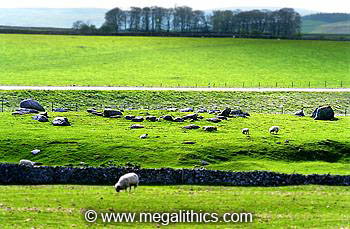
 |
Photo Gallery |
|
Panoramas |
||
| NY 56824 17751 (GPS 26min). | Outer 27.4 x 30.2m, Inner 12.7 x 14.2m (Meas.). |
| Visited 1987 to 2002 | No magnetic anomalies. |
Gunnerkeld (Old Norse for the "Spring of
Gunnarr" ), stands in farm land 2km north of Shap and only scant metres
from the M6 motorway. The circle seems to have had a charmed life, as the
motorway is not the first transport project to threaten it in recent times. In
1844 the proposed route of the Lancaster and Carlisle railway line lay right
through the circle, and it seemed that Gunnerkeld was destined to suffer the
same fate as poor Kemp Howe only 5km to the south. Luckily the Earl of Lonsdale,
who was the landowner at the time, intervened and the railway was diverted,
sparing this megalithic rarity.
Gunnerkeld is a concentric stone circle, this is a very scarce monument class
with only 15 known definite examples in England. This site is part of a cluster of
concentrics in the Lake District with other definite examples at Oddendale, The
Druid's Temple and Shapbeck, there are also several "possibles" including Hird Wood and Howes
Well. There is a classification system for concentric circles and
Gunnerkeld falls into class A (the most common), a
double concentric irregular stone circle.
Gunnerkeld's nested circles are not embanked and stand on a low ridge that runs N-S parallel to the nearby motorway. As can be seen from the photo above, the uneven topography and the size of the monument make it difficult to get a good overview of the site. Because of the accumulated damage to the rings, it is not possible to tell if they had been height graded in any way.
We measured the outer ring at 30.2m N-S, 27.4m E-W, it has been pointed out that the famous Castlerigg circle has very similar dimensions at 30.5m N-S and 28.7m E-W (our measurements). Barnatt (1) places the original stone count of Gunnerkeld's outer ring at 32-42, we counted 18 stones surviving with 15 fallen, 1 leaning and 2 erect, the stones of both rings show mixed petrology and are probably all local glacial erratics. The outer ring has suffered extensive stone robbing, particularly towards the north where only three stones survive, but they do include the only two fully erect stones. These two stones are 1.7m and 1.4m high and stand just east of true north, they have been interpreted by Burl (2) as being possible portals to an entrance, this is a common feature in Lakeland rings, the similarly proportioned Castlerigg also having a northern entrance. Whilst the stones in question are undeniably prominent today, their height and spacing would have been shared by many other circle stones when the the ring was intact, leading Barnatt (1) and ourselves to doubt the portal assumption.
The central ring of concentric circles is almost always made up of the kerbs of the central cairn or feature, Barnatt does not consider this to be a stone circle proper, and consequently gives scant coverage in his corpus. Our stone count for the inner ring was 31 and, as is usual in concentric circles, these stones are generally smaller than those of the outer circle. We measured the inner circle at 14.2m N-S and 12.7m E-W, the stones being arranged almost contiguously, they were almost certainly used as kerbs for the internal platform or kerb-cairn. Burials have been found in every concentric circle excavated so far, and Gunnerkeld is no exception, at the centre of the rings is a shallow pit containing a solitary upright slab, all that remains of the cist that once lay there.
With so few definite concentrics known, and the presence of proven multi-phase development at some sites, the dating of these monuments is unclear. The present timeframe for concentric circles is thought to be Late Neolithic to Early Bronze Age, a period of about 1500 years.
Although there are other concentric circles in the Lake District, we think that Gunnerkeld, even in its ruined state, is the most impressive. The stones here are much bigger than those at Oddendale and the Druid's Temple, and we think that the circle has the feel of the "big circles" of the Lakes about it. If Gunnerkeld had survived the ravages of time as well as the other Lakeland gems of Castlerigg or Swinside, they would have a serious rival to contend with.
1. Barnatt J. Stone Circles of Britain, B.A.R. 215(ii)
Site 9:14, 1989, Oxford
2. Burl A. A Guide to the Stone Circles of Britain, Ireland and Brittany. Site
79,1995 Yale University Press